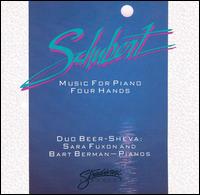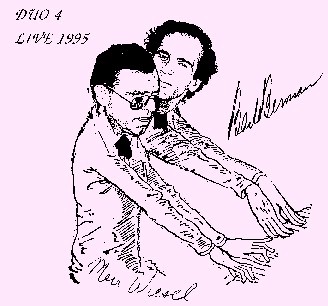|
NOTES ON FRANZ SCHUBERT Analysis of Five Piano Duets by Bart Berman |
|
Rondo in A Major, op. 107 (1828)This piece is built according to an AB1ACAB2A scheme, B1 and B2 having a Dominant-Tonic relation. An allegretto quasi andantino reveals itself, written in 2/4 metre and accompanied by quiet sixteenths. Its dotted upbeat is to play a role in the course of the work. Then a transition theme in F sharp Minor serves as a link with the B1 section, which consists of a lively theme with two equally important melodic lines and another in larger note values. A flowing intermediary section leads back into A, slightly varied and ending with a brief introduction to C. This is a characteristic motif based on the upbeat of the Rondo and, above it, broken chords in staccato triplets. The second part of B1 returns in various tonalities until the A Major of the main theme is again reached. Since the B2 section retains the same key, the composer seems to feel the need for an intermezzo which now follows, switching to F Major and based once more upon B. After the intervening section already known to us, we hear the main theme played by the second player, the first now accompanying. The B theme seems to have the last musical word, but our main melody reappears in a free canonic arrangement, concluding with a trill in the highest region of the Schubertian key board. Variations on an Original Theme in A flat Major, op. 35 (1824)The theme is a slow march with a two-quarters’ upbeat, not unlike the Variations in E Minor, op. 90.
Variation V is written in Minor and has the same rhythm as III. reminiscent of the slow movement of Beethoven's Seventh Symphony. Flowing accompaniment. Variation VI: maestoso. Both parts feature chords and passages. Variation VII: pp dynamics con sordino (left pedal). Piu lento. Two ff interruptions. Ends with a transition coming to a halt on a Dominant harmony followed by a cadenza in the treble. Variation VIII is notated in 12/8 metre, allegro moderato. Accompaniment as in Schubert's song Die Post from the Winterreise cycle. After the variation proper, a free finale starts in bar 229 with a charming new melody and with much virtuosity, concluding with some mighty chords. Sonata in B flat major, op. 30 (1818)First movement - allegro moderato. An introductory cadenza leads to the beautifully singing main theme, continued by a forceful triad figure in dotted quarters. Then the Dominant key of F major combines staccato triplets with broken octaves in the soprano, which then improvises a transition to D flat. An intimate melody is heard, derived from the previous motif, octaves now below it, with the upper voices adding a canon. The mood becomes more joyous, triplets switching to legato. Then trills in treble and bass join these elements. A new melodic idea and a codetta in F conclude the Exposition. The Development section begins with the dotted triad heard earlier, which is to serve as the basis for a dramatic climax. An entirely different melody in A Major brings us back to the recapitulation, concluded by two more chords above a bass line. Second movement - andante con moto. The composer exposes a D Minor theme in Lied form. Then the Major key of B flat provides the only musical material other than that of the main theme, which itself inspires an E flat Major melody modulating to an A Major section, and a broad cantilena preparing the return of the theme "translated" into D Major. A coda confirms the Major mode. Third movement - allegretto. Surprisingly, this movement starts on the same D Major harmony as the slow movement's final one. Thus it seems logical to leave only a short pause between them. The main key of B flat soon establishes itself. After a brief hesitation, the second theme begins in G flat Major, proceeding to D flat but then to F Major. The development section consists wholly of a theme in D Minor. A short cadenza reminiscent of the first movement reintroduces the main theme, upon which at last also the coda is based. Fantasy in F Minor, op. 103 (1828)This piece is dedicated to Countess Caroline Esterhazy, linking a famous music-lovers’ name not only with Joseph Haydn but with Franz Schubert as well. The first movement, an allegro molto moderato. starts as an accompaniment in quavers, the main theme entering at the end of the second bar. Soon we arrive at the tonality of A flat Major. The Secundo part takes the initiative with a melody derived from the main theme and answered by the right hand of the first pianist, with the accompaniment transferred to his left-hand. The main tonality returns in the Major mode, then the serene atmosphere gives way to a staccato theme, resolute in character, again in F Minor. After an interesting harmonic change the main theme reappears in D flat Minor, accompanied by triplets. Likewise we hear the second theme in the key of A Minor, followed by our main theme, this time in F Minor. Then the other one is transformed into a legato version in F Major. A short transition follows with once more the harmonic change twice mentioned leading into a largo in F sharp Minor. This movement, with its dotted rhythms, could be interpreted as a French overture and makes us understand why the Dutch conductor Willem van Otterloo has orchestrated the piece. The initial largo theme returns played very softly but followed by ff chords as before, preparing the entrance of an allegro vivace. This too has an F sharp Minor key, now in a Scherzo mood. Its Trio is to be played con delicatezza. After the Da capo, the Dominant 7th chord on C sharp serves as a link with the recapitulated F Minor theme (tempo primo). It is followed by a fugue based on the second staccato theme and from its start supported by a counterpoint motif. A forceful climax comes abruptly to a halt. The main theme sounds for the last time, concluded by a few expressive chords. All above piano duets are included on a CD by Duo Beer Sheva, Bart Berman and the late pianist Sara FuxonVariations on a French song in E minor, D624
(????)
|
NOTES ON FRANZ SCHUBERT Introduction Analysis of Five Piano Duets The Unfinished Piano Sonatas Completing the Unfinished Sonatas Questions & Answers Links BART BERMAN
CURRENT ENSEMBLES COMPOSITION & ARRANGEMENTS IN MEMORIAM CONTACT |
 Variation I is written in triplets, the bass giving hints of the
theme. Variation II presents the theme in somewhat changed form,
accompanied by sixteenths. Variation III has a different tempo: un poco
piu lento. The upbeat now consists of a quarter and two quavers,
imitated in several voices. Variation IV: Primo and Secundo alternate
with sixteenths and with staccato chords.
Variation I is written in triplets, the bass giving hints of the
theme. Variation II presents the theme in somewhat changed form,
accompanied by sixteenths. Variation III has a different tempo: un poco
piu lento. The upbeat now consists of a quarter and two quavers,
imitated in several voices. Variation IV: Primo and Secundo alternate
with sixteenths and with staccato chords. 